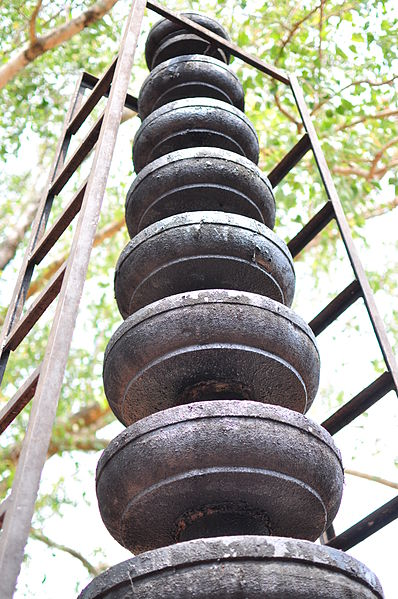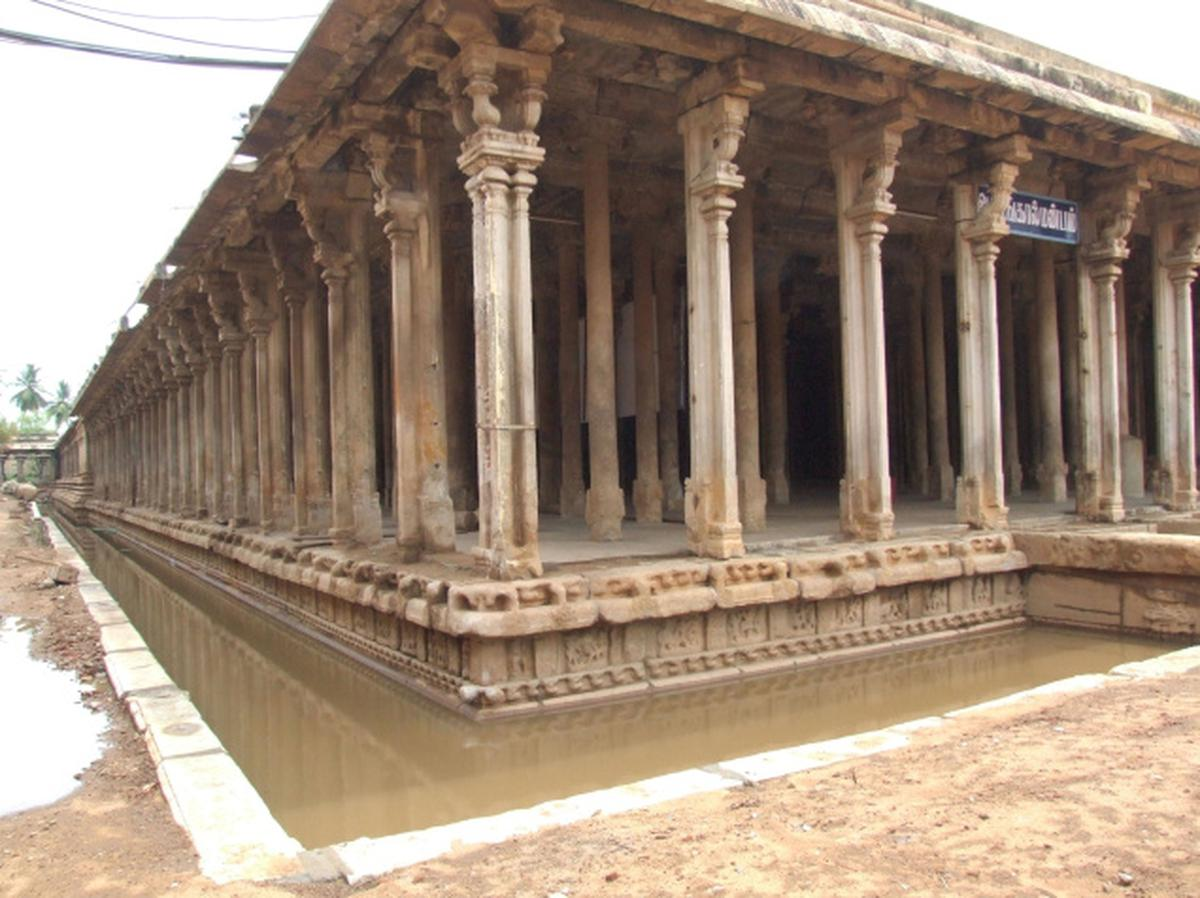 |
| MadapamAndal Renga Mannar Temple,Sri Villiputhur, TN tripadvisor.in/ |
Pillars play a very an important role in various cultures across the globe. So are they in the traditions and cultures across India. They symbolize religious, political and historical perspectives. For the monarchy, they stand as a symbol of victory or power. In politics, they may stand as memorials to the departed leaders of repute or people died for a cause. In the places of worship - in the Hindu temples they symbolize the supremacy of all- pervading God over other things including the king or local head. The pillars made of stone in the front part of the temple carry temple flag and oil lamp implying the presence of divinity where dark forces have no place . The Dwajasthambam (flag pole) and lamp post (made of stone or metal) are an integral part of the temple architecture. In Kerala temples, in front of the entrance Gopuras one can see what is called big 'ammai valakus', stone tortoise-shaped lamp-stands. It is believed they symbolically represent the primordial support of the Universe integrating role of Pancha boothas - five natural elements that sustain life on earth, aesthetics and religious heritage. Pillars embody the energetic role of a king under the direction of divinity that will ensure prosperity and welfare of the kingdom.
With respect to pancha boothas it is worth mentioning the following life-sustaining elements and divinity:
Eternal Sky/ Ether: Parameśvara - that in which everything is contained. ...
Air: Representing God Vāyu & Hanuman-movement. ...
Fire: Representing Gods, Agni & Shiva – transformation. ...
Water: Representing Gods Varuṇa & Viṣhṇu – preservation. ...
Earth: Representing Goddess Bhudevi & Brahma - creation.
 |
| Stone oil lamp, kerala temple, Commons Wikipedia |
 |
| Stone oil lamp (Kal Vilakku), Kerala temple invisstock.com |
Countless Hindu temples across south India have huge halls - mantaps supported by rows of decorative pillars. There are some mantaps on the temple premises that have more than 900 pillars. In Tamil Nadu Srirangam Ranganathar temple and Madurai Meenakshi temple have 1000 pillar mandapams. Calling them 1000 pillar hall (Aayiram Kaal mandapam) is not right and they actually have less than 1000 columns.
In the case of historic one Thousand Pillar Temple or Rudreshwara Swamy Temple in Hanamakonda, Telangana State, India, the hall has exactly 1000 ornate stone pillars supporting the massive ceiling. Representing the intricate Chalukyan style of temple architecture at its finest, the temple is dedicated to Lord Shiva, Vishnu and Surya and is replete with richly designed pillars, finely carved icons, and rock cut elephants with incredible detailing. It was added to the tentative list of World Heritage sites recognised by UNESCO other sites in Warangal district.
 |
| 1000 pillar hall, Ranganathar temple, Srirangam, TN, talesofanomad.com |
 |
| sculptured pillar with eaves and brackets La pakshi temple, APasoulwindow.com |
 |
| Ranganathar temple, hanging eaves Srirangam,thehindu.com |
Above image; A huge mandapam at Srirangam Ranganathar temple, TN. A typical mandapa is a portico or colonnaded (series of columns placed at regular intervals) hall that provides space for a large number of worshippers. Dances, religious discourses and some rituals for the festival idols are held here. An important part of Hindu temple architecture. Some temples have multiple colonnaded mandapas in different sizes named as Ardhamandapa, Mandapa, and Mahamandapa............................
 |
| South Indian temple architecture. adyan.urd.ac.ir |
In Hinduism the idea of pillar is to establish the concept that God is supreme and omnipotent. Divinity is greater than anything including the king. A stambha or column made of hard stone in temples sometimes bears inscriptions and religious emblems implying divinity is permeating in every part of the place of worship. It means our focus must be on the divinity once you are inside the tmple.
India’s first religious pillar is around 1,900 years old called Garuda pillar built in Vidisha, Madhya Pradesh by a man called Heliodorus, Greek ambassador to the Shunga kings. It is near to the Sanchi Stupa. - Heliodorus dedicated this pillar to god Vasudeva.
 |
| Heliodorus pillar 113 BCE , MP. upload.wikimedia.org |
Ashoka was first to establish India’s first pillar commemorating his kingship. It is said, he had more than 84000 pillars built to mark the 84000 relics of Buddha across India. All of them were free-standing pillars topped by a royal symbol, thus they have political and religious connotations. Only a handful of them are left today.
 |
| Puthu Mandapam, Meenakshi temple, Madurai.maduraitourism.co.in |
Hence, many Hindu Maharajahs ruled their kingdoms in the name of gods or goddess. The Nayaks of Madurai ruled the kingdom in the name of Goddess Meenakshi. The rulers of Travancore ruled their kingdom on behalf of God Vishnu, Padmanabha Swamy. Naturally, in many parts of a Hindu temple, including the pillars, you can see the stone carved images of god or something related to divinity.
 |
| 1000 pillar hall Meenakshi temple, madurai. seawatersports.com |
 |
| Sculpted pillars at Shesharayar mandapam,Srirangam talesofanomad.com |
Indian temple architecture gives importance to every part of the temple right from inner sanctuary to the entrance gopuram or tower. There are many mandapams in the temple and each one has certain features and is comparable to the organs in the human body. Entrance Gopuram stands for the feet of the man and the Altar stands for navel.
The following are some of the halls meant for specific purposes:
Muka Mandapam - May be a porch or small hall in front of the entrance of the temple; hence this pavilion is called mukhamaṇḍapa (mukha- face + maṇḍapa- pavilion). It is a regular feature of the Dravidian temple architecture.
Ashana Mandapam (stands for knees) where religious discourses are held before an audience.
Nirutha Mandapam (stands for thighs) - Here the processional deities (Uchavars) are reverentially placed for the worship of the devotees during certain festivals like Navaratri,eetc.
Artha Mandapam (stands for neck)- It is the space between the temple exterior and the garbhagriha (sanctum ) or the other mandapa of the temple. Garbha Graham or Sreekovil stands for head. It is the innermost sanctuary of the temple associated with inner prakara and Namaskara mandapam. Here. devotees prostrate before the deity, meaning "surrendering to thee"
Ranga Mandapa or rangamandapa – A larger mandapa, which can be used for dance or drama, with music
Vimanam stands for the top of the head. This hall may have well-carved stone pillars depicting episodes from the Hindu epics. You seldom will find pillars in the sanctum.
 |
| 1000 pillar corridor, Ramanatha Swamy temple, Rameswaram, TN. |
Above image: The long corridor of 1000 pillars of the Ramanathaswamy Temple in Rameswaram, Tamil Nadu, India........................
Nootru or Ayiram kal mandapam – Hall of 100 or 1000 pillars. As mentioned above, only temples that can be counted on the fingers have 100 or 1000 pillar mandapams. In Tamil Nadu, Kanchipuram, Madurai, Rameshwaram, Chidambaram and Srirangam have temples with massive halls supported by 1000 pillars or 100 pillars. Rudreshwar temple in Telangana is popular for 1000 pillars. A few are are listed as UNESCO world heritage sites. A Mandapam (hall) with 1000 pillars made entirely of hard rock is an architectural grandeur. The 1000 pillar hall at Ramanathaswami temple at Rameshwaram forms the longest corridor in the world.
Other mandapams are as follows:
Yaga Mandapam – Mandapam where Homa/Yaga/ are performed occasionally. These are big enough to accommodate many people. Many temple do not have this type of hall and may build temporary pandal for this purpose with lots of open space to avoid fire mishap.
Manjana Mandapam – Bathing rituals for some special deities are done here for theerthavari. The tradition in Kerala has been that the uchava idol is taken to the nearest waterbody for this ritual marking culmination of a festival, Same is true of Tamil Nadu temples.
Murasu Mandapam – This hall is meant to beat drums /Murasu informing starting of any temple rituals. It is specifically designed so that the drum beats will be reverberating far and wide. The temple in kerala has hall called Kotturpara, meant for beating drum during festival period.Example: Thrikodithanam Mahavishnu Temple.
Kalyana Mandapam –There is no such a specific mandapam in temples to hold the celestial wedding of the goddess and god. Srinivasa Kalyanam, Tirupati and Meenakshi Sundareswarar Kalyanam, Madurai are very famous and are held yearly in a specific hall.
A devout Hindu must have a purpose besides his given or chosen duty. The purpose of life for Hindus is to achieve four aims, called Purusharthas . comprising dharma, kama, artha and moksha. They impart the needed experience to lead a moral and ethical life. The Hindu temples help them focus on their goals including renunciation and salvation free from rebirth.
https://learningthursdays.com/temple-mandapams/
https://www.templepurohit.com/hindu-temple-architecture-structure-human-body-symbolism/








.jfif)
